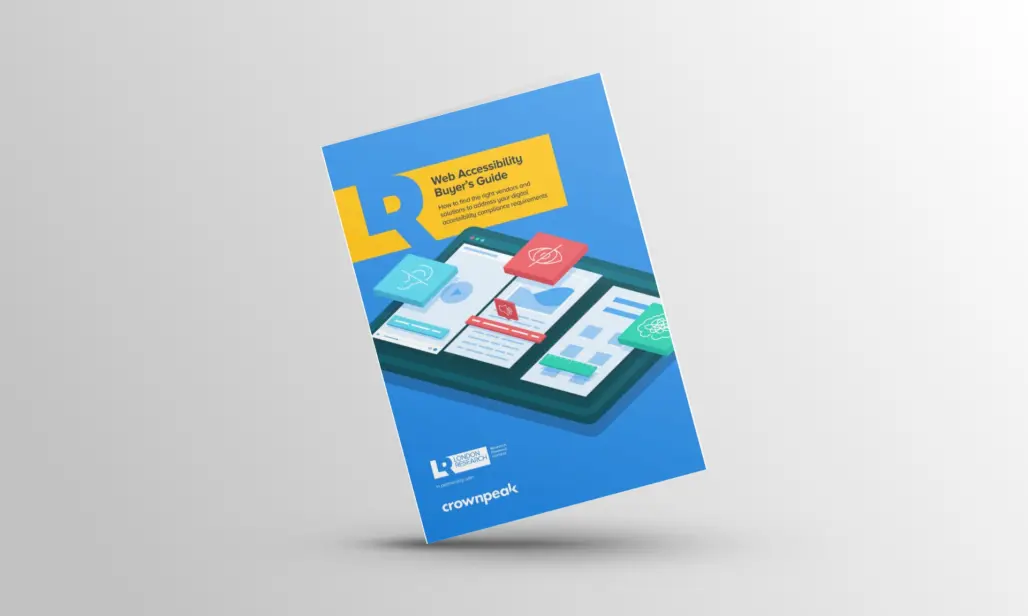Bridging The Digital Divide: How Choosing The Right Vendor Can Help Brands Close The Accessibility Gap

With just 3% of the world’s top one million websites accessible to people with disabilities, the digital divide is real - and a real barrier to independent living for more than a quarter of the population. A new report from London Research and Crownpeak looks at how engaging the right digital accessibility partner can help brands transform user experience, drive innovation and mitigate their legal risk, in a way that has benefits for all.
Brands want their digital offerings to be accessible to everyone. But if there’s a disparity over who can and cannot access their products and services, they may be failing to reach the people in their own backyard. That’s the message underlined in a new report from London Research in partnership with Crownpeak.
The Buyer’s Guide To Web Accessibility highlights a global market of one billion people with disabilities, with a spending power of more than $13 trillion in annual disposable income. In fact, around 20% of all web users have some form of disability. However, this customer base continues to be woefully under-served, with many going to a different site if their specific needs aren’t met.
Failing to meet accessibility standards can cost brands dearly in other ways, too. In the US, where application of the Americans with Disabilities Act (ADA) is robust, ecommerce accessibility lawsuits are at an all-time high, reaching 4,061 in 2022. Many claims begin as demand letters to businesses that are settled before a lawsuit is ever filed. Ignoring demand letters comes with significant legal risk and opportunity costs, with average ADA settlements ranging from $20k to $200k, reaching up to $6M.
Building the business case for digital accessibility
While the receipt of reputation-harming legal demand letters may spur brands into taking action, the report identified that stakeholder buy-in still remained a barrier to digital accessibility in the absence of this sense of urgency. Remediation projects were seen as costly and cumbersome, with low return on investment. However the report identified further benefits and opportunity costs that could help senior leaders build the business case for their digital accessibility efforts.
- Improving accessibility can drive innovation. Contrast guidelines, eye-tracking technology, text-to-speech and speech-to-text were initially created for people with disabilities, but are now features enjoyed by everyone.
- Brands could expect to see a 5% to 20% lift in their SEO and marketing performance by using accessible design techniques.
- Accessibility commitments can strengthen brand image in a trust-oriented market. In a Gartner Report, senior director analyst Brent Stewart stated that, “By 2023, digital products in full Web Content Accessibility Guidelines Level 2 compliance will outperform their market competitors by 50%.”
Why a digital accessibility partner is key to solving the accessibility puzzle
Getting and remaining accessible remains a puzzle that many organizations attempt to solve using piecemeal solutions and quick fixes that are unlikely to mitigate legal risk long-term. Accessibility plug-ins and overlays aren’t fully compliant, while manual audits may only provide a one-time fix. The report highlighted that the best accessibility partners offered solutions that provide brands with a hybrid mix of both.
This gold-standard approach can help senior leaders avoid the minefield of solutions that cost too much money, waste time, and don’t effectively mitigate risk. But the right digital accessibility vendor can also help brands prioritize the remediation process, using advanced reporting features that allow companies to track their level of compliance over time - an important defense in the face of a demand letter.
Choosing the right accessibility partner
Digital accessibility has existed as an industry for several decades, meaning specialists have accumulated years of expertise in the field. Specific services and costs vary considerably from one vendor to another, making it difficult for brands to evaluate the best partner for their own organizations.
Choosing the right accessibility partner is the key to accelerating and improving brands’ accessibility efforts, something that just might transform the user experience for people with disabilities. With a step-by-step guide to best practice throughout the vendor selection process, the Buyer’s Guide To Web Accessibility is an invaluable resource for senior leaders trying to improve the accessibility of their own digital offerings.